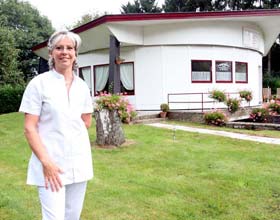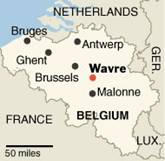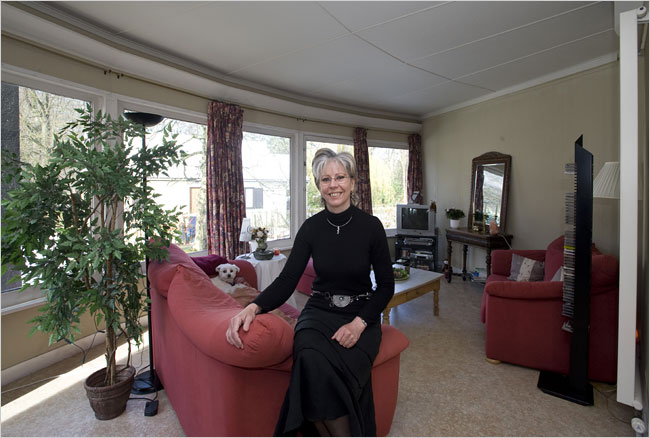
La Maison Tournante de Wavre
(Belgique)

La Maison Tournante de Wavre
(Belgique)
Article 1
(04/09/2008)
© DEMOULIN
L'incroyable Maison Tournante a les honneurs du très prestigieux
New York Times
WAVRE Fait exceptionnel. Le prestigieux New York Times, 1.200 journalistes, 1,2 milion d'exemplaires vendus (portés à 1,7 million le dimanche), 98 Prix Pulitzer et une devise célèbre : "Toutes les nouvelles qui méritent d'êtres imprimées", consacre 80 lignes à une maison peu banale qui existe en Belgique. Notre confrère John Tagliabue précise que la maison est à vendre, ce qui est exact. Il s'agit de l'incroyable Maison Tournante, une villa située au Bois de la Pierre, à Wavre, inaugurée en... 1958, à l'occasion de l'Exposition universelle de Bruxelles. Unique en Belgique, sa particularité est en effet de tourner complètement sur elle-même, sur 360 degrés donc, à la vitesse d'environ 32 mètres à l'heure.
A son inauguration au printemps 58, la Maison Tournante était présentée comme "la Maison de l'An 2000". On écrivait que son concepteur, François Massau, qui n'était ni ingénieur ni architecte mais avait du génie, était trop en avance sur son temps. Au départ, le projet de M. Massau, en réalisant cette maison, était de permettre à sa femme malade d'avoir du soleil toute l'année sans quitter son living. En effet, François Massau, mort en 2002, n'a jamais réussi à commercialiser son invention; il fit même la grève de la faim dans les années 60 pour obtenir l'aide de l'état. Depuis cet article dans l'un des quotidiens les plus prestigieux de la planète, le site Internet de la Maison Tournante est consulté de partout dans le monde, de Brisbane en Australie à San Francisco en passant par le Bresil.
C'est ce qu'explique, pas peu fière, Mme Dominique Quinet, l'actuelle propriétaire; celle-ci fixe son prix (à discuter) à 345.000 euros. Le quartier est un des plus beaux de Wavre. A Malonne, une autre Maison Tournante avait été construite et même pourvue de deux vitesses de rotation, mais le système n'a jamais vraiment fonctionné. En ce sens, celle de Wavre est vraiment unique.
Elle tourne dans les 2 sens. La villa ne possède de poste de pilotage, plutôt un tableau des commandes : un bouton et hop !, la villa et son living-salle à manger, sa cuisine et ses 4 chambres, d'une surface au sol de 130 m2, se mettent à tourner sur elles-mêmes, sur des rails, à la vitesse d'un tour en 90 minutes. Bien que non équipée de panneaux solaires, la villa (avec déjà du double vitrage !) garantit des économies précieuses d'énergie. Dominique Quinet se souvient d'un hiver rigoureux. Du -15 degrés dehors mais dans son salon, 30 degrés sans chauffage.
Installé dans les caves, le moteur n'est pas plus gros (mais est moins bruyant : on n'entend rien !) que celui d'une machine à laver. Un BBQ ? Vous pivotez la maison sur le jardin ! Trop de soleil. Ou bien, tout en repassant, surveiller d'un oeil la petite qui joue dans le bac à sable ? Une pression du bouton et la villa tourne.
Bon, à vrai dire, nous y avons eu le... mal de mer, mais c'est sans doute une question d'adaptation. Mme Quinet y vit avec son chien Zarah qui s'accommode parfaitement de l'absence de repaire. En revanche, elle a possédé jadis un chat qui y devenait fou à trouver souvent la porte du garage à une autre
Gilbert Dupont © La Dernière Heure 2008
Article 2
A Builder’s 360° Vision Didn’t Move His Neighbors
By JOHN TAGLIABUE
Published: September 1, 2008
WAVRE, Belgium — With energy prices rising, François Massau, a local coal merchant-turned-builder who died here impoverished and alone in 2002 at the age of 97, is enjoying a small measure of posthumous fame, though not here in his hometown.
The New York Times Jock Fistick
The 1,400 square-foot revolving house built by Francois Massau in 1958 still turns, making a complete circle in 90 minutes, admitting more sunlight into its rooms as needed.

Wavre, like the rest of Belgium, is often cold and dark.
The New York Times

Jock Fistick
“It’s the most beautiful house in Wavre,” said Dominique Quinet, a beautician who lives in the house.
In the 1950s, when few people talked about ecology or conserving energy, Mr. Massau built what was among the earliest revolving homes. He built it in 1958 so his sickly wife, a schoolteacher, could enjoy sunshine and warmth any time of the day or the year. (There often isn’t much of either in Belgium.)
Today, as energy prices soar, revolving buildings have become fashionable. In southern Germany, Rolf Disch has built a solar-powered rotating house; in Dubai, in the United Arab Emirates, David Fisher, an Israeli-born Italian architect, plans an 80-story rotating skyscraper, the Dynamic Tower. Some call it sunflower architecture.
The technology Mr. Massau pioneered was so effective it still works today, and all three of the revolving houses he built remain operational. Yet on the 50th anniversary of his first house, there will be no ceremonies, no special tours or honors.
“There’s total indifference,” said Guy Otten, a retired journalist who often wrote about Mr. Massau. “He was always seen as eccentric. He was never appreciated here.”
He spent most of his later years unhappily, in court with government agencies and building contractors seeking money he believed he was owed. His wife and three of his four children died before he did, at least one, his son Julien, taking his own life.
“He did everything himself, alone, with his own hands, with no money, and maybe it was this that the family could not bear,” said Nicole Van Haren, a former neighbor. “It was a somber family.”
Even now, in a stylish neighborhood on a rise above Wavre, stands Mr. Massau’s first revolving house. Its circular brick and concrete foundation is stationary, supporting a steel track on which the house revolves, moved by a small electric motor. Its roof, a concrete slab supported by columns, is stationary, too.
“It’s the most beautiful house in Wavre,” said Dominique Quinet, a beautician who lives in the house and has her business there, too. As a toddler, her daughter often played in the sandbox outside. “If I worked in the kitchen,” Ms. Quinet said, “I simply moved the kitchen to where the sandbox was, so I could keep an eye on her.”
She pressed one of two green buttons on the living room wall, and the house moved imperceptibly but for a slight creaking noise. She pressed a third, red button to stop it. The house moves slowly, making a full 360-degree turn in 90 minutes. “If it’s warm, I can move the living room into the shade,” she said.
An ingenious part of the house is the tangle of plastic pipe and electrical switches in the cellar that assure a steady supply of water and electricity and removal of sewage waste even while the house is turning. The 1,400-square-foot house, which has four bedrooms, a kitchen and a large crescent-shaped living- and dining-room, is energy-efficient. On sunny winter days, when snow lies outside, it can be a comfortable 70 degrees inside, without heating, Ms. Quinet said, if the house is turned to the sun.
The people of Wavre are clearly divided in their view of Mr. Massau. In 1958, as he struggled to complete his first house in time for the opening of the Brussels World’s Fair, old photos show, local dignitaries, including Wavre’s mayor, admired his creation.
The dignitaries brought admiration, but no money. By 1968, Mr. Massau was forced to sell the house to Ms. Quinet’s father, Paul, to finance construction of more rotating houses. After paying Mr. Massau for the house, Paul Quinet extended loans to him, hoping to be repaid when Mr. Massau sold his houses.
“But he never sold them,” Ms. Quinet said. “My father would say, ‘Sell the houses, but pay me back.’ My father had to go to court. Mr. Massau was not correct in his attitude. But then, he was not a businessman.”
Ms. Quinet’s father was not the only legal adversary. Over the years, court cases multiplied, as Mr. Massau sued government agencies and contractors who had worked for him. He became a sad figure.
“He went on hunger strikes, and I remember as a boy seeing him demonstrating in front of town hall with posters hung front and back, explaining his legal troubles,” recalled Jean-Marie Duquaine, spokesman for Wavre’s city government. “When he was 85 years old, he’d be out there distributing fliers explaining his lawsuits.”
Those who defend Mr. Massau say his was a typical case of the outsider crushed by the establishment. “He was not an architect, he was not an engineer, he was not a builder,” said Philippe Willems, Mr. Massau’s grandson, who lives with his wife and two children in the second of Mr. Massau’s three houses, in Malonne, a village south of Wavre. “He was a coal merchant, a mason. He sold everything to build his houses.”
Mr. Willems’s parents bought the house from his grandfather so he would have money to keep building, he said. “If you turn the house five times a day, you change your home, you change the light, you change everything,” he said. “I’m in love with this house.”
This year, after 35 years, he had to replace the electric motor that drives the house, he said, but he has had almost no other mechanical problems.
This year, Ms. Quinet put her Massau house up for sale, for $507,000, because it was just too big. “I am alone, I don’t need it,” she said. Despite its fame, it has drawn only one prospective buyer. “People are mistrustful,” she said. “People think it’s expensive, difficult to maintain.”
“You need someone who is looking for something special,” she said.
A version of this article appeared in print on September 2, 2008, on page A6 of the New York edition.